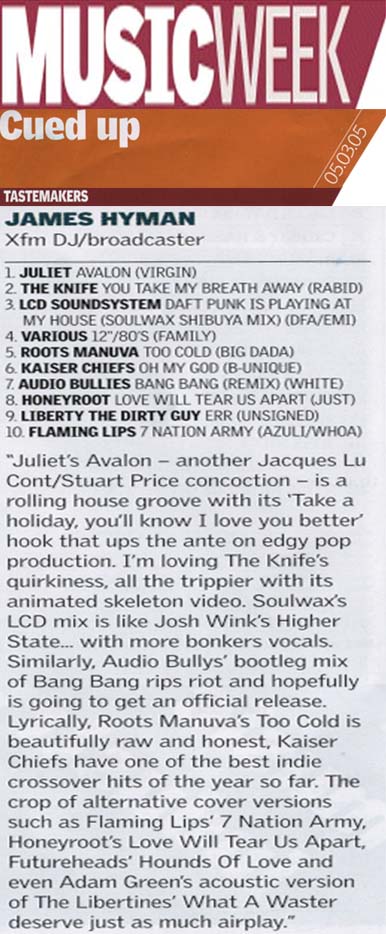Literally typing the word 'Paedophile' (& hyper-linking it too!!) gets you feeling weird, paranoid and uncomfortable; is that a knock on the door?? Phew, I'm OK!!
Right now Paedophilia has hit Pop-Culture's radar hard what with Jacko's trial & Jonathan King's early release on Tuesday. With Jacko, I do believe it's half a dozen of one, 6 of the other i.e. he's gone very wrong somewhere but so have certain parents and $$-eyed close associates.
Jonathan King's creepy grin, arrogant smug denial and loud, self-publicized innocence gives rise to unsettling intrigue. Today 'The Sun' began its 'Don't Give King A Thing' campaign, urging readers to boycott downloading King's 'My Love, My Life' single.
This raises a question I've wondered for a while now, probably triggered at the time when Gary Glitter's sparkle fizzled out. How sour and dangerous can Pop Idols become before mainstream media totally blanks their musical legacy and past huge hits?
When I play Michael Jackson's "Billie Jean" in a club, it always gets positive whoops & cheers, no wonder, it's a class record with class Quincy Jones production. If MJ's found guilty, will we still hear, play and download his seminal songs on the radio, MTV, I-Tunes etc.?
Gary Glitter's abuse of his celebrity status and subsequently, young teenagers was totally inexcusable but lots of his tunes were, and I think, still are awesome. "Another Rock & Roll Xmas" and "Leader Of The Gang" - glam-pop stompers! Will we ever hear those on those "I Love Xmas/I Love The 70s" type programmes? Will Film/TV makers feel forever tainted by what they know about him and others, thus avoiding using music by the criminal connotations songs evoke?
Rebel-rouser, 'The Killer', Jerry Lee-Lewis married his young cousin in 1957 causing a fair degree of moral outrage; his music is still heard and placed in Film/TV to this day.
I'm not being Devil's Advocate for the hell of it or more importantly labelling any of the above artists as paedophiles, rather here's a provocative debate about when and what levels of crimes/circumstances does previously wide-spread music suddenly become censored, in fact, totally wiped off hard drives.
Can't recall where I first read about this latest trash/swap-shop phenomenon, maybe one of those free mags found in Soho shops; whatever I like its eco-vibe and at this fairly early stage, wonder how it will develop? Some say, it's the next Craiglist.

Of course, easy to find plenty of free media out there (the net etc.), but hard finding quality mags that cost zero. Here's some I've chewed on - all London based & free. Spread your love & respect to those producing them as they're pretty much doing it for those same reasons.
Always exuding that fresh printing press whiff, FACT; oh the smell of it!!! Contents so fresh too, often turning me onto plenty of sub-pop-culture. Current issue got me moist with pieces on WFMU radio, the rarest of rare record labels, 'Black Patti', Surf Movies, Johnny Trunk's 20 best Movie Soundtracks, plus Woebot's excellent 'expose' (!) on grime DVDS!!!
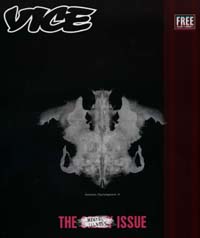
Touched on 'Vice' in the 'Wake Up & Smell The Ink' blog. Tend to get it from Soul Jazz and, as I said before, major props. Recently, its themed issues are provocatively similar to how Colors mag was when it began, though Vice's over-all editorial is wittily razor-sharp. Last month, the Sex issue, this month, 'The Mental Illness' issue - smart & sassy, with Michelle, a featured mental patient sub-editing the music features (!!)
Grabbed this from Berwick St. 'Church', towards the end of 2004. Its smooth broadsheet newspaper format was bursting with great pieces on Throbbing Gristle, Interpol, Kris Kristofferson, UK rappers 'Infinite Livez', Memphis Starfucker writing about seducing the woman found dead in Phil Spector's house, Robert Frank's Rolling Stones flick, 'Cocksucker Blues', the Roland MC-909 plus plenty of reviews. That was issue 1, I'm waiting and hoping for issue 2....
Also found in Berwick St. 'Church', buried under the mountain of flyers, this is free in select stores. Issue 5's editorial shows the true devotion in fuelling a fanzine, aiming to take it mainstream and like every free mag. mentioned here, I wish the editors, in this instance Suzy & Ian, total success. Plenty of bite-size media morsels rest alongside printed breaths of fresh air such as art-anarchist, James Cauty (one half of KLF), designer toy culture featuring Pete Fowler, the Tiki scene (which gave me flashbacks to a teenage barmitzvah at London's Trader Vics!!), blues legend Robert Johnson and again, 'nuff reviews.
FULL MOON, EMPTY SPORTS BAG
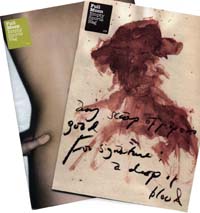
Pretty sure it's 'Church' again if you want this one (Jesus, do I live there or what?!!). Lots of emotional well-written shorts e.g. issue 9 where Dot Allison pens a piece on the void of fame and Rose McKnight's intro-spective tight 3-columns on loneliness.
Brazil blew me away a lot last year, musically for the punked-up energy of this 'Baile Funk' compilation and Diplo's dabblings. I clocked this read the other week when I DJ-ed with Yoda at Cargo, as it lay in the restaurant area. Simply Brazilian culture including a short 'Spice' on Seu Jorge who rocked it in 'City Of G-d' & strummed that tearing David Bowie 'Life On Mars' cover in 'The Life Aquatic'.
With that same fresh smell as 'FACT', this is snippets galore - books, events, web, music, film, games, fashion and guest columnists.
Least glossy of the lot but so what! Sincere info. and as the title suggests, music based.
Plopped into my Xfm pigeon-hole, this has just reached double figures and now monthly. Like 'Loud And Quiet', plenty of heart-felt music content.
Circa 1991, I was badly bitten by the mag. collecting bug, walking past Vintage in Brewer St. with a couple of my mates pointing at 'The Face Magazine - Electro Issue' in the window. After hours, months & years of rooting out basement back-issues of Playboy, Rolling Stone, The Face, i-D etc. it was no suprise to bump into fellow geek/digger Quentin Tarantino today, trawling film posters.
He told me he still hasn't listened to the QT mix-CD!!
Regular readers of this blog will know how much I bang on about the endless geek-fuelled passion to collecting, often bordering on obsessive! This guy's close to my heart:
Thousands of books, keyrings, bottles, cartoon characters, comic strips, cake decorations . . . Is Tony Butcher Britain's most obsessive collector?
By Roya Nikkhah
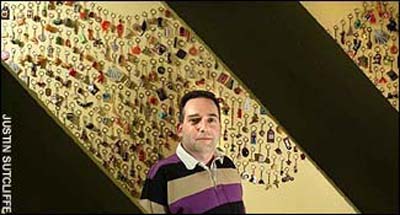
Tony Butcher insists that he is not crazy. "Some people might consider me a bit of an oddball, but I'm really not nuts," he says. For the 44-year-old IT consultant, the accolade of the world's most extraordinary collector is nothing to be ashamed of.
Mr. Butcher has been collecting since he was a child, but recently attracted worldwide attention after setting up a website to sell some of the tens of thousands of items that he has amassed over the past 40 years. E-mails have flooded in from as far as Australia, Japan and Brazil.
Striking though the website is, however, it is nothing compared with Mr. Butcher's house – which has become a shrine to his hobby. The sitting room houses more than 9,000 cartoon figures on shelves that cover every inch of the walls.
Instead of pictures, his collection of 600 keyrings adorns the walls of the entrance hall and limited edition cuddly toys jostle for space on either side of the staircase.
"When I was a child, I was never bored because I was always adding to my collections and doing little displays," he says. "It started with shells and marbles and grew as my interests widened."
His interests are certainly wide and have produced collections of 307 sweet cigarette and candy stick boxes, to lanterns and complete sets of the McDonald's Mr Men range.
"Not a lot of people know this, but you can actually buy a McDonald's toy without having the meal," he says proudly.
Although he lives alone, Mr. Butcher bought a four-bedroom house to display his collections. "I moved in three years ago and am still unpacking," he says. Boxes with his picture card collections and sweet jars full of cake decorations have still to find a home.
"The colour scheme was just awful when I arrived – all dreary beige walls, but I think the way I've done it shows off my collections,'' he says, sweeping a hand around red and lime green walls.
Most of the ground floor is taken up with his library, home to 20,000 books arranged into comic strip books, television novels and television science fiction annuals.
"I have always loved Dr. Who memorabilia and I have every Dr. Who book issued," says Mr. Butcher. A custom-made wooden Tardis in the upstairs library, which houses the complete Dr. Who video set, confirms his passion.
Mr Butcher's collections of glass animals, 200 porcelain whimsies, 600 cereal toys and Yogi Bear annuals finally got the better of him recently, leading to his website that he uses to sell only duplicate items with other collectors. Last week, Mr. Butcher's website crashed when too many people tried to access it. He hopes to have it running in the next few days. The site is visited by 600 people a week from all over the world, desperate to see if Tony's Trading can find a rare Thunderbirds figure. Americans, says Mr Butcher, are particularly keen buyers. "I recently sold a Fred Bassett annual which I bought for 5p at a car boot sale for £48," he says triumphantly.
The response to his obscure collections is positive, but to some web-surfers, it is just too bizarre.
Mr. Butcher says that he was mortified when he recently received e-mails attacking him. One read: "I want to burn your house down and watch you cry," another - "You deserve to be murdered for wasting your life." "That really hurt," he says.
Mr. Butcher insists that there is room in his life for other hobbies. He is a keen gardener and visits his friends and family as often as he can.
His mother, Sheila, says that although her son may seem odd to some people, she is used to his peculiar interests.
"Ever since he was three years old, Tony was collecting ice cream spoons and bottle tops," says Mrs. Butcher, 66.
"His house is like an Aladdin's cave and there's always something new to see. If he won the Lottery, I'm sure he'd buy a castle and fill it with more things."
Mary Strila, an IT consultant and friend of Mr Butcher's, is in awe of his collections. "Tony's collections are amazing," she says. "The scale and variety of his things are what makes them unique." He has 900 glass bottles, 5,000 match boxes and 100 teapot lids.
Mr. Butcher dismisses any implication that his obsession with cartoon characters, particularly Disney, is a little childish. "I love them because they are so cleverly drawn and humorous," he says. Bugs Bunny is his favourite.
Neither, he insists, is his obsession for collecting an addiction. "I have gone for three or four weeks without buying anything, but there really is nothing quite like the feeling of completing a set when you have been looking for something for ages."
"It took me a few years but I now have every hand-painted Kinder Egg toy issued. That made me very happy." Mr. Butcher says that he has no idea how much he has spent on his collections, but is sure that it adds up to many thousands of pounds. Every penny he earns is spent on a sought-after item or new display cabinet for his collections.
"Spend it while you've got it, that's my motto," says Mr. Butcher. "After I buy my cigarettes and food, everything else goes on my collections. It's what gives me the greatest pleasure in life."
Although he says that he is not extravagant, Mr. Butcher recently spent £132 on a Magic Roundabout plastic train. His collections are as precious to him as children, and he couldn't possibly choose a favourite.
"I love them all equally, although annuals are my current focus," he says. Animals are banned from the house and his nieces and nephews are "under strict control" when they visit. Neither can he bear to be away for too long – holidays are out of the question and Mr. Butcher will rarely travel further than a two-hour drive for fear of a break-in.
Although there are a few spare shelves left in Mr. Butcher's house, it will not be long before he needs more space. What, then, will he do when his cartoon characters need to branch out? "I'll find a way to buy next door."
Cargo, Friday night & time to watch Yoda go to the movies:
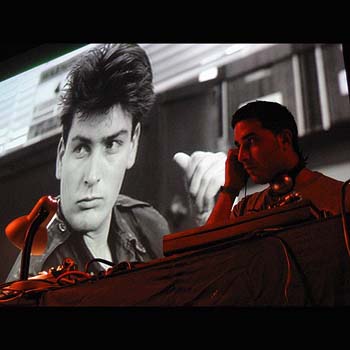
I hadn't seen such a fever-pitched Cargo crowd since the Avalanches set, 16 November 2001 or when Eddy & I DJ-ed alongside Soulwax for that legendary December 2001 Remix night (pictured below):
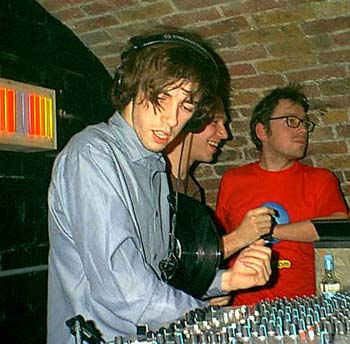
I took my 'seat', minus popcorn, right of stage and was immediately dazzled by Yoda's Pioneer DVJ-X1's, twin Technics decks, Vestax mixer & monitors providing and projecting a visual pot-pourri of pre-dominantly 80s audio-visuals that included 'Scarface', 'The Big Lebowski', 'The Running Man', the dueling banjo sequence off 'Deliverance' (now I realise where Aphex may have got his twisted look from!), 'Masters Of The Universe', Jacko's 'Billie Jean', DMC Mixing championships footage and of course, healthy Yoda namechecks from 'Star Wars'.
Many have paved the way for live 'Visual Scratching', in recent years, Coldcut with V-Jamm, Eclectic Method & Hexstatic, the latter Yoda told me inspired him to show off his own VJ-ing style & fashion. For me though, Yoda's made VJ-ing the most palatable and all-round entertaining. Smiling people watched, cheered, jaws dropping in excited amazement; unlike other VJs, the force was with Yoda who had a core crowd dancing to his familiar rhythms and beats.
Like my Jazzy Jeff/Will Smith gig, I thought, how can I follow this; all my DVD battle weapons were at home! Fortunately, the worry soon vanished as, like my recent Barcelona set, the open-minded crowd were well up for it.
I love playing a straight techno, hip-hop or house set but when I can really mix it up, that's the lick. Friday night's crew got hyped to everything from old skool rave classics like Stakker's 'Humanoid', Prodigy's 'No Good', banging booties a la Phil 'N Dog's 'Dr. Pressure' & Tarantino mash-ups right through to drum & bass doozies e.g. Fugees "Ready Or Not" (torn up by Hype/Zinc), Orbital's 'Dr. Who' (timely with Dr. Who back on the beeb!), the Kaiser Chiefs etc, ending my set at 3AM, the floor still rammed with the Chemical Brother's next single "Believe" pumping.
Had this on my hard drive for ages and after catching Yoda in action on Friday night, thought it's time to share & get this out there for y'all geeks, TV/Film/Media students etc. My chronological rough draft to all things 'Scratch Video', 'TV Sampling' etc.
Any glaring omissions, modifications, praise or feedback, contact Green Bandana.
VIDEO SCRATCHING
(VID.ee.oh skra.ching) pp. Manipulating video footage, especially by looping and reversing scenes to achieve an effect or to follow the beat of a song. - video scratch n.
1963
Nam June Paik exhibits modified TV sets at Galerie Parnass in Wuppertal, blurring the boundaries between art and everyday life, adopting dadaesque confrontational strategies and responding to the theories of American composer John Cage regarding the uses of chance, randomness and indeterminacy whilst creating art. Typical for many artists at the time was a critical view of broadcast television, a communication channel still in its infancy, but already regarded as a monolithic tool of marketing and official propaganda.
Paik is famed for having said “Television has been attacking us all our lives, now we can attack it back”. (Here Paik may have been deliberately paraphrasing John Cage’s statement “ The Europeans have been sending opera over here (America) for centuries and now we are sending it back”)
Paik’s statement wasn’t a case of “Video Art killing the TV star”, moreover he considered the broadcast space of television as an expanded arena for art.
1965
"Button Happening" is Nam June Paik's earliest videotape, and possibly his first tape ever. Recorded in 1965 on the day he acquired his first Sony Portapak camera, this technically fragile piece documents a single performance action - Paik buttoning and unbuttoning his jacket. A spirit of conceptual Fluxus humor underlies this seminal recording.
1969
Nam’s the man again when, on the day that America's first moon shot revolutionized space travel, he revolutionized Video art with the premiere of the "TV Bra,"; visitors at the Corcoran witnessed Charlotte Mormon playing cello topless save for the three-inch television monitors mounted on her breasts.
1972
David Hall, an experimental film maker and ‘scratch-TV’ pioneer, founded the first department for video art in the UK at Maidstone College of Art. He made a series for the BBC ‘7 TV Pieces’. This series consisted of short black and white films, each of which playfully deconstructed the illusory space of the TV image whilst subverting the expectations of the viewer. Some years later, Hall produced another work for the BBC, ‘This is a Television Receiver’ in which the BBC’s most famous news anchor of the day, Richard Baker, read a technical description of what a television is and how it works. This short reading was repeatedly re-taped by shooting the screen image, until both image and sound degraded to a point of almost total abstraction.
Again in the late 80’s, Hall was commissioned to make a work for television and on this occasion he “reconstructed” the first experimental TV transmission of the pioneer engineer John Logie Baird. Baird’s version of television was never commercially developed, and Hall’s work thus functions both as an archeological account of the early years of the medium and as critique of the linear history of technological development.
1973
Video Art continues to sows the seeds for ‘Scratch TV’ with other early examples such as Richard Serra’s ‘Telervision Delivers People’ and Nam June Paik’s, ‘Global Groove’:
“This is a glimpse of the video landscape of tomorrow, when you will be able to switch to any TV station on the earth, and TV Guide will be as fat as the Manhattan telephone book."
So begins Global Groove, a seminal tape in the history of video art. This radical manifesto on global communications in a media-saturated world is rendered as a frenetic electronic collage, a sound and image pastiche that subverts the language of television. With surreal visual wit and an antic neo-Dada sensibility, Paik manipulates an emblematic pastiche of multicultural elements, artworld figures and Pop iconography.
Included in this ‘media mash-up’ are Pepsi commercials appropriated from Japanese television, juxtaposed with performances by avant-garde artists John Cage, Merce Cunningham and Allen Ginsberg and the Living Theatre; dancers moving in a synthesized, colorized space to Mitch Ryder's Devil with a Blue Dress On intercut with traditional Korean dancers as well as Charlotte Moorman, her image wildly synthesized, playing the TV Cello; Paik and Moorman play the TV Bra for Living Sculpture and Richard Nixon's face is distorted by a magnetically altered television.
In an ironic form of interactive television, Paik presents "Participation TV," in which he instructs viewers to open or close their eyes. Paik subjects this transcultural, intertextual content to an exuberant, stream-of-consciousness onslaught of disruptive editing and technological devices, including audio and video synthesis, colorization, ironic juxtapositions, temporal shifts and layering -- a controlled chaos that suggests a hallucinatory romp through the channels of a global TV.
1974
Nam June Paik’s "TV Buddha" in which a Buddha sits like a cross-legged kid, glued to its own image on a TV screen.
1978
American artist Dara Birnbaum unleashes the most memorable of her ‘Pop Pop Video’ works, 'Technology/Transformation: Wonder Woman’, a rapidly edited montage of images from the popular tv series Wonder Woman welding the irreverent aesthetics of punk to a formal avant garde tradition and the so-called “drastic classicism” of New York’s post-minimalist new music milieu.
1 AUGUST 1981
Neil Armstrong’s attorney calls MTV days before their launch insisting they remove the famous landing on the moon quote/sample, “That’s one small step for man, one giant leap for mankind”. Last minute editing saves the day and at 12:01AM a male voice-over announces "This is MTV, music television," with guitar chords played in the background as a hyperactive spaceman bounced across the moonscape, putting an MTV banner on the surface of the planet and avoiding legal action via MTV’s proposed ‘scratch TV’ sampling to launch the station.
JULY 1983
Jazz legend, Herbie Hancock reaches UK top 10 & US No.1 with 'Rockit'. The Godley & Crème directed video depicts robots carrying out pedestrian tasks, while much of the footage jerks back and forth in tandem with the scratching in the song. That editing style crops up again almost 2 decades later in clips for Orbital's "The Box," Roni Size/Reprazent's "Brown Paper Bag", Swizz Beatz' "Guilty" and the Michel Gondry-directed “Around the world” for Daft Punk. Godley & Crème’s 'scratch' technique (almost before the term is coined!) heavily reflects the record's 'scratches' by GrandMixer DST (widely acknowledged as having invented the idea of scratching vinyl).
The video scoops 7 nominations at the 1st MTV Video Music Awards, winning ‘Best Concept’, ‘Best Special Effects’, ‘Best Art Direction’, ‘Best Editing’ & ‘Most Experimental’.
“Rockit’s” live performance, seen by millions on The Grammy Awards Show and Saturday Night Live was the spark that lit the imagination of an entire generation of turntablists/scratch DJS (Q-Bert, Cut Chemist, Faust, Babu etc.) who all enthuse this fact in Doug Pray’s ‘Scratch’ film-documentary.
Roo Aiken who edited “Rockit” went on to edit over 200 pop-promos for The Police, Ultravox, Duran Duran, Spandau Ballet, F.G.T.H., Wham!, George Michael, U2, Culture Club, Elton John, Pet Shop Boys etc. - admittedly, the golden age of ‘pop video’ i.e. the 80’s.
In the late 90’s, Roo Aiken edited all MTV & Play UK Megamixes with James Hyman.
1984
Scratch video, a strand of ‘Video Art’ is born. Its aggressive aesthetics stretch boundaries between different media, creating new fields of research for video experimentation. People soon realised that a ‘VCR’ had more use than just catching up on missing episodes of soap-opera so inspired by the likes of William Burroughs & Bronx DJs, collectives like the ‘Duvet Brothers’ (Rik Lander & Peter Boyd Mclean) confronted the political and cultural issues of 1980's Britain, including the divisive conservatism of Margaret Thatcher's social policies, the Northern Ireland conflict and concern over America's defense build-up during the Reagan years via their cut-up shorts e.g. ‘The Arms Trade’, ‘Laughing Girls’, ‘War Machine’ and ‘Blue Monday’, the latter appropriating television footage of political events set to New Order’s music.
New York clubs like ‘Area’ & Manhattan’s Danceteria (an early Madonna haunt) were seeing early stages of ‘Video-Jockeying’ (‘VJ-ing’) where young video artists wanted to develop and expose their work in a social context outside the mainstream gallery world. Dave Dorrell remembers a typical scenario of Debbie Harry (Blondie) and Andy Warhol grooving to Grandmaster Flash whilst ‘VJs’ armed with cameras, would instantly turn footage of clubbers’ feet into the projected ‘live scratch’ mix.
In London at Brixton’s “The Fridge”, a group of young artists including George Barber, The Duvet Brothers, Sandra Goldbacher and Kim Flitcroft arranged weekly screenings, showing their re-cut versions of tv commercials and Hollywood films on a heap of old tv sets bound together with heavy steel chains. The images would often be accompanied by music that existed at the point of transition between post-punk new wave, American hip hop, techno and Jamaican dub.
1 JANUARY 1984
Good Morning Mr.Orwell is an edited version of Paik's first international satellite "installation,", held on New Year's Day 1984 and could be seen as a template for U2’s “Zoo TV” tour almost a decade later. Paik's trans-cultural satellite extravaganzas link different countries, spaces, and times in often chaotic but entertaining collages of art and pop culture, the avant-garde and television. Good Morning Mr.Orwell, which Paik saw as a rebuttal to Orwell's dystopian vision of 1984, linked France, Germany and the U.S.
The event featured vibrant performances by Laurie Anderson, Merce Cunningham, Peter Gabriel and Allen Ginsberg. Paik coordinated the event and designed the TV graphics that connected the various live and pre-recorded segments. This project can be seen as a development of Paik's thinking on the potential of satellite communication, as proposed in A Conversation, and realized with his typical pastiche of art, entertainment, and cross-cultural juxtapositions.
APRIL 1984
Former Sugarhill Records session drummer, Keith Le Blanc, under the 'Malcolm X' guise releases a Tommy Boy single, "No Sell Out", pitched against the infamous DMX drumbeat. Way ahead of its time, it does scrape the UK top 75 (no.60) and its promotional promo 'borrows' political riot footage and Malcolm X speech-bytes.
JULY 1984
Also way ahead of their time, in fact, pre-empting Emergency Broadcast System’s “Guerilla media” style & stance, Godley & Creme create several video versions, for Frankie Goes To Hollywood’s “Two Tribes”, all based around the infamous Superpowers’ (Gorbochov & Reagan) wrestling match. The 12” Video Destructo Mix (aka Hibakusha mix) includes black & white newsreel footage of President Nixon stuttering, “Keep the peace” and again, was edited by Roo Aiken who can now only re-call this era of editing as, “a blur”.
NOVEMBER 1984
Art of Noise have their first UK top 10 hit with ‘Close (to the edit)’. As VH-1.com states, “If "Rockit" raised the bar for the art of music videos, MTV's Experimental Video for 1985, Art of Noise's "Close (To the Edit)," set a new standard both conceptually and stylistically. The clip, directed by Polish avant-garde filmmaker Zbigniew Rybczynski, features long, single-edit shots of a little punk girl guiding three men in laying waste to musical instruments, such as demolishing a piano with a buzzsaw, a chainsaw and a power drill. Much of the footage is sped up and jittery, and the visuals are stark and industrial.
The Prodigy’s “Firestarter” clip pays quick ‘scratch’ homage to ‘Close (to the edit)’ with Keith Flint replacing the little punk girl in response to Liam Howlett’s sampling of the track.
1985
Duvet Brothers produce ‘Chat Show’, ‘Pillow Talks’ & ‘War Machine’,
Gorilla Tapes uses wildly irreverent humor to craft an indictment of Reagan and Thatcher in “Death Valley Days”.
MAY 1985
Paul Hardcastle reaches no.1 in 13 countries, selling over 4 million copies of '19', a song about the Vietnam conflict, with a video-clip full of stuttered/cut-up Vietnam footage; bombs, recruits getting heads shaved and the immortal liners, “Wasn’t really sure what was going on” & “N-nnn-one of them received a hero’s welcome, none of them, none of them, none of them!!!”
JUNE 1985
"The Motorcade Sped On," condemned to purgatory by copyright laws (CBS wouldn’t clear the Newscaster Walter Cronkite’s samples for starters), is a hip-hop requiem for John F. Kennedy" (Culture Jammers Keyboard Magazine) and for visual effect 'samples' footage from the assasination itself. Spurred on by Coldcut’s request if there was a video, Steinski created one 2 years later with editor/director John Kane who had access to a stock film house that had plenty of the JFK assaination news-reels. Ardent ‘frame-spotters’ may note one or two ‘black holes’, as Steinski would say, “Work in progress”.
22 MARCH 1986
Big Audio Dynamite’s achieve their first chart success with their 2nd single, “E=MC2”, based on Nik Roeg’s films. According to the band’s official web-site (bad.co.uk), “E=MC2” was, “Generally credited as the first rock hit to use sample techniques”.
Roo Aiken edits the video which includes cheeky clips from Nik Roeg’s “Don’t Look Now” & “Man Who Fell To Earth”.
JUNE 1986
Art of Noise hit UK no.12 with “Paranoimia”, ably assisted by Max Headroom, the world’s first computerized presenter/VJ with an inimitable ‘scratch’ style and delivery.
The "Catch the Wave" campaign for new Coke, created by McCann-Erickson New York, aimed to connect with an emerging youth-oriented target audience. With a clear message: to drink the "in" taste, to identify with the "in" image, drink Coca-Cola.
Accordingly, to appeal to America's youth, The Coca-Cola Company enlisted an unusual "spokesman": Max Headroom, a computerized character with a synthesized voice. Headroom, created by London video producers Rocky Morton and Annabel Jankel, was originally intended for use in music videos. Actor Matt Frewer played the role and helped Headroom earn his status as a new-wave hero.
The Coke ad featuring Headroom was selected as the top commercial campaign of 1986 by Video Storyboard Tests, Inc. of New York. Headroom was so popular with the public that the Coca-Cola Atlanta Consumer Information Center received more calls about the character than it had for any previous Coca-Cola advertising campaign.
Roo Aiken edited all episodes of the Max Headroom TV series.
31 JANUARY 1987
Steinksi & Mass Media scrape the UK top 75 (no.63) with “We’ll be right back”,
a melange of 50’s & 60’s advertising slogans & sound-bytes, brilliantly reflected in the black & white promo which samples much of the same. All the audio was original, filtered with air-conditioner and footage came from Kenny & Adam’s ‘Image Ways’
Ovaltine in the UK were so impressed by this piece of ‘audio-visuality’ that they
picked up the rights to the track, using it for their commercials with a similarly styled vid.
Max Headroom returns to star as spokesman in new "Catch the Wave" commercials for Coke, as well as a pair of "Coke Pop Quiz" ads. One ad, "He's So Hip," featured Headroom with basketball great Michael Jordan.
5 SEPTEMBER 1987
After producing some short MTV idents full of cut-up flavour for Jon Klein in the summer, M.A.R.R.S. (Dave Dorrell/CJ/Martin Young/Steve Young & AR Kane) hit the UK no.1 spot with “Pump up the volume” which becomes the biggest selling 12” for that year.
The video, directed by Vaughn Oliver (4AD Records’ designer) predominantly plunders ‘public domain’ NASA footage, a concept which became the fabric for 4Later’s “The Trip” series 11 years later.
NOVEMBER 1987
Eric B & Rakim’s “Paid in full” gets a ‘7 minutes of madness’ remix by Coldcut (Jonathan More & Matt Black) which includes a lead vocal sample from Israeli/Yemenite singer, ‘Ofra Haza’. The “This is a journey into sound” sample was mock lip-synch and the record company used scrolling cod-arabic text for Ofra Haza who was in fact Israeli/Yemenite. Consequently, MTV’s Peter Good & James Hyman received numerous fatwas every time the clip was aired.
20 FEBRUARY 1988
Tim Simenon’s ‘Bomb The Bass’ projects smashes into the UK charts at no.2 and like M.A.R.R.S. uses ‘stock’ cut-up visuals to reflect its frantic ‘bedroom DJ makes hit single out of samples’ approach.
London Records give ‘cheap’ a new meaning when they use exactly the same sepia-flavoured stock 40’s/50’s/60’s ‘dance’ footage, without changing the shots for three ‘house’ music classics i.e. Steve ‘Silk’ Hurley’s “Jack Your Body”, Adonis’ “No Way Back” and Tyree’s “Turn Up The Bass”.
1988
Ultratech & early MTV promos/idents strobing madness, early Sat/AM
‘Eurotechno’ was created with video artist Mark McClean who at the time used a state-of-the-art Fairlight graphics box to create a 25 minute acid house video.
Pellington developed an idea for non-linear collage program. Created in partnership with MTV Europe producer/director Jon Klein, "Buzz" was an ambitious thirteen-part global series commissioned by MTV and Channel 4 (UK). Hailed by critics as ground-breaking adventurous television, "Buzz" was the logical culmination of Pellington’s MTV career.
His clips for such noted rock, pop and rap performers as U2, Public Enemy, Disposable Heroes.
Pellington brought his commentary on television and distinctive media manipulation techniques to large stadiums around the world when he created the multi-screen image environment for U2’s highly acclaimed "Zoo TV" tour.
Duvet Brothers and Gorilla Tapes who in this programme offer us The President's World (1988). Ronald Reagan's old films are intercut with news reportage reinterpreting his political career as a poorly scripted Hollywood romance...
1989
Time Warner ask John Kane & Steinski to produce a 60 second spot for a 2-hour ‘Earth Day’ special with a ‘We need it now’ deadline. The New York Times said the phenomenally
fast-cut piece (edited by John Kane & Glenn Lazarro), “out MTV’s MTV” and can now be seen in the Museum Of Modern Art.
Unreleased ‘Megamix’ pilot, over-night session
Casanova, Fast Eddie, Pump Up The Jam (titles to ‘Wired’ TV show)
9 APRIL 1989
Metallica’s “One” single reaches no. 35 in the US charts with 3 video clips to accompany its release. One version mixes a band performance, shot on December 6th 1988 in a Los Angeles warehouse with extensive movie footage from the movie "Johnny Got His Gun", based on the book by Dalton Trumbo who also directed the movie in 1971. The movie is about a soldier who's arms and legs were blown away by a grenade during World War I. Metallica purchased the rights to this film to use it for the music video.
KC Flightt’s “Planet E” single features cleared samples of David Byrne/Talking Heads, “Once in a lifetime”. Rather than sample the Talking Heads video, David Byrne makes a cameo in Flightt’s clip.
JULY 1989
In a typical chaotic record company scenario i.e. “Let’s cobble together a video quick, as we have a potential hit on our hands”, a mish-mash of stock footage, predominantly cartoons is assembled for a 1-minute clip for Doug Lazy’s “Let it roll”. As the clip is so short, MTV use it frequently to fill in their ‘Top Of The Hour’ slot and it becomes one of the most played videos for that year, amassing major royalties for artist & record company (Atlantic) alike.
1991
Video artist Phil Patiris transformed network news footage, clips from Star Trek, and sports coverage into a critique of the media/industrial complex with his 19 minute short, “Iraq Campaign”.
JUNE 1992
Utah Saint’s “Something good” single goes UK top 5 and its accompanying £3K clip, directed by Jerry Hibbard (a local News Reader!) is probably the first to sample another pop video WITH permission i.e. Kate Bush’s “Cloudbusting”, the latter featuring a cameo by Donald Sutherland. Mr Sutherland was not used in the Utah’s video as it would have taken another 6 weeks for his permission.
The band did offer a reward for anyone who could get them the cloudbusting machine from the original and loads of freaks got in touch saying they didn't have the original but had built something similar but better!!
Negativland
The story behind this track and why it is officially "unavailable" is perhaps one of the best-known cases of a corporate giant record company crushing obscure artists in the name of intellectual property. In summary, U2’s label, Island Records, sued Negativland and SST Records for trademark and copyright infringement. The resulting fiasco inspired Negativland to publish a book, Fair Use, which meticulously documents the entire affair.
U2's publicist in L.A. contacted Mondo 2000 magazine on behalf of the group's guitarist, The Edge, with the idea of doing a rare interview concerning the group's Zoo TV tour and its use of technology. Mondo editor R. U. Serius then, without The Edge's knowledge, contacted Don Joyce and Mark Hosler of Negativland with an invitation to participate in the interview. On June 25th Negativland joined R. U. Serius to await the following call from The Edge in Dublin.
The following is heavily edited ‘highlights’ from the interview:
Mark: I got the idea from talking with R.U. Serius that you were interested in talking about the impact technology is having on people and cultures.
E: Our position is a very unique one. We are a very big band. We have access, technology, access to the airwaves, be they TV, radio, or whatever. We're a little more relaxed at this point in time about being a big band, because we've turned it into a part of the creative process. We're actually using our position in a way that gives us a certain amount of amusement. It's turned it into part of what we do. A few years ago we were almost uncomfortable with the idea of being a big band. It seemed like maybe coming from where we did and being interested in the things we were interested in, it seemed like a bit of an anomaly, a bit of a contradiction.
The whole Zoo TV thing, the access that being where we are gives us, has given us a lot of enjoyment. We're playing around...we've got TV specials coming up which are really hilarious. We did this satellite link-up with MTV where we beamed our show into somebody's front room. The possibilities are only beginning to present themselves.
M: I think what you're saying sounds great. If you get to a position where you've got the power, the money to do something, and you still maintain this idea of exploring and doing something interesting and fun, that's really great. But it seems like when you get to be a certain size- you're an international cultural phenomenon- and it seems like a lot of what you're doing, when you look at it and analyze it, might be pretty subversive...but it ends up being lost on a huge number of the people who are following what you're doing.
I don't know if that's something you just realize, and it's part of what it is...
E: Yeah. We're not shy about being big anymore. I think rock and roll should be big. It's about mass communication. We're in a position where we can do some more wild things and I would think it would be a shame if we just accepted the standards and the way that most bands go about their business, and didn't use this position in a different way.
M: I wanted to ask you something more about the Zoo TV tour. One thing that wasn't really clear to me- you have a satellite dish so that you can take stuff down live off of various TV transmissions around the world?
E: Yeah, essentially the system is, like we've got the big screens on the stage which are the final image that's created. Down by the mixing board we've got a vision mixer which mixes in, blends the images from live cameras, from optical disks, and from live satellite transmissions that are taken in from a dish outside the venue. So the combination of images can be any of those sources. We've also incorporated telecommunications. We've got a telephone onstage that Bono occasionally makes calls from the stage and occasionally calling the White House or ordering pizza or whatever...um, phone sex...
Don: So you can kind of sample whatever's out there on the airwaves...
E: Yeah, it's kind of like information central.
M: One thing I'm curious about- there's been more and more controversy over copyright issues and sampling, and I thought that one thing you're doing in the Zoo TV tour is that you were taking these TV broadcasts- copyrighted material that you are then re-broadcasting right there in the venue where people paid for a ticket- and I wondered what you thought about that.
D: And whether you had any problem, whether it ever came up that that was illegal.
E: No, I mean, I asked the question early on- is this going to be a problem?, and apparently it, I don't think there is a problem. I mean, in theory I don't have a problem with sampling. I suppose when a sample becomes just part of another work then it's no problem. If sampling is, you know, stealing an idea and replaying the same idea, changing it very slightly, that's different. We're using the visual and images in a completely different context. If it's a live broadcast, it's like a few seconds at the most. I don't think, in spirit, there's any...
D: So you would say that a fragmentary approach is the way to go.
E: Yeah. You know, like in music terms, we've sampled things, people sample us all the time, you know, I hear the odd U2 drum loop in a dance record or whatever. You know, I don't have any problem with that.
D: Well, this is interesting, because we've been involved in a similar situation along these lines...
RUS: In fact, maybe it's time for me to interject here. The folks that you've been talking to, Don and Mark, aside from being occasional contributors to Mondo 2000, are members of a band called Negativland.
E: Ahhhhhh!
RUS: And I figured- I know they've been sued by your record label, but they hadn't been sued by you. So I thought we could engage in a conversation. And I know you might feel like we're out to surprise you or sabotage you, but just to engage in...
D: But anyway, we were sued by Island for a very fragmentary sample of one of your records.
E: Yeah.
M: We ended up sending some packages of stuff along to you and some letters, and I don't know what kind of communications you personally ever got about it.
E: Yeah, well from what I can remember, I can't remember the exact sequence of events, but as it was presented to us, you know, "Here's the record, here's the album sleeve, Island are already on the case here, and they've objected because they feel it's, because of the artwork, this is at a time where a lot of people are expecting a new U2 record," and they felt that, from their own point of view, in a pure business sense, nothing about art, I just think they felt there was a chance that people would pick up the record in a record shop and think, "Oh, this is the new U2 album."
M: But that actually was...I mean, in the context U2 is in, you have an idea of doing something that's subversive, and we're scurrying around way down low in the underground of music, and we're doing things that we also think are somewhat subversive...but the thing that we did was- You know, the lawsuit from Island dealt with this as if it was a consumer fraud that was intended to rip off innocent U2 fans, and that we were somehow gonna make millions of dollars by selling these records. And of course it didn't acknowledge that there was any- they may not like the artistic intent of the record, you know, you and your band might be offended by what we did, but no one ever in any way acknowledged that the record was anything else. And yet, actually, when you look at the cover and you listen to the record, look at the whole package, there's a U-2 spyplane on the cover and stuff- it's pretty obvious that this is actually an artistic statement...again, you may not like it, but it's a statement about something.
E: I wasn't, I didn't have any problem with it. I think Casey Kasem could have. I mean the problem really was by the time it really, by the time we realized what was going on it was kinda too late, and we actually did approach the record company on your behalf and said, "Look, c'mon, this is just, this is very heavy..."
D: Oh, what did they say?
E: But at that point, on the point of principle, their attitude was, "Well, look, OK, we're not gonna look for damages but we, we're not about to swallow our own legal costs." The way it ended up, they were looking for costs, not damages.
M: Right, but what happened, we didn't get a phone call from Island saying, "Look, we're pissed. We don't like what you did. Our band has a new album coming out and you better pull this thing or we're gonna smash you." They didn't give us any chance to do anything. The first thing we heard was, ten days after the record was out, there's a 180-page lawsuit.
M: The other feeling we had, which we were kinda talking about earlier with the Zoo TV tour, was we said: Look, a long time ago when artists were- artists are always reacting to their environment right? You're always doing something that's reacting to the world you're in, so what are the tools or the technology you had a few hundred years ago to do that? Well, maybe you had a paintbrush, you had a piano, a lute. You could interpret things that way, and the way we see it now, and it sounds like perhaps you agree, is that now the technology is simply different and now it happens that instead of just making a painting of something I can take a photograph, a video, I can make a xerox, I can make a sample...
M: ...And you can capture it, and our environment is- and it's something you're suggesting in the Zoo TV tour too- the environment is this media-saturated thing that we live in.
E: Yes.
M: And to us it was like, on the one hand I know that U2 is a bunch of guys just trying to make some music, but at another level, U2 is part of the media environment we live in, you know, I hear your songs playing in the shopping mall in the background when I'm shopping, whether I want to or not.
E: Yeah.
M: And so for us to ask permission to do something that's in response to the environment we're in, which is something McGuinness said to us very early on: "Oh, you should have asked us"- and we sort of felt from a business standpoint, that's one way- but from an artistic standpoint, we felt that No, we don't need to. This is just the world that we're in.
D: See, your response to sampling is the absolutely correct one, I think, which is: if it's fragmentary it's OK, no one should really worry about fragmentary appropriation of anything.
E: Yeah.
D: You know, the public domain is actually, literally the public domain and if it's in it, let's use it. And we're against bootlegging entire works completely- that is ripping people off- but the idea that all this stuff is out there surrounding us, and we're swimming in it, the idea that it could become part of your own work is perfectly appropriate and, in fact, necessary as a kind of self-defense against the coercion that media has become...and yet the business end of it, your label and every other label, has an archaic view of this, based on their own ownership of all that culture.
E: Yeah.
D: And so part of what we're about now, especially since our own lawsuit, is to bring all this out in some way, even to the point of changing the copyright laws, which is what I'm onto right now- I would really like to relook at the copyright laws in this country and the way that you can't even sample two seconds of something because it's owned. I think it's totally wrong, and has to be changed in this age of new technologies that are basically about capturing things.
E: Yeah, well, technology has really paved the way for this. We're in a new era. The technology is the means to create in music...
D: But the laws have not caught up with that at all.
E: Absolutely, yes. I mean ultimately it does no one any good if creativity is stopped because record companies are losing money. I suppose the fine line is between where a sample or using somebody else's work is pure theft and plagiarism, and where it becomes a legitimate new thing, and that I suppose is where whatever new legislation, that's where it's really going to be difficult to be clear.
D: I think it's going to be akin to deciding whether something is pornographic or not, it's going to be the same kind of tricky definitions there, but I've come to the conclusion that, actually, I would make the defining guideline in the law be whether or not it's, in effect, a bootleg of a complete, self-contained performance, or whether it's a fragment, any part. I would just say using any part, but not the whole, is OK. Now of course you'll get to the point where someone would try to exploit that definition and use all but the last ten seconds of a song, but that's a case for the judge to say "No, you're really just pushing it there and that's wrong." Like pornography, they can make a decision about that. But to me, I'd like the law to say that any fragmentary use of another person's work is free- absolutely free, and they don't have to pay royalties, and they don't have to pay rights, and they don't have to get permission. They can just use it because it's there.
E: Yeah, I'd be up for that.
D: And that would just be part of working in the public domain. If you're going to be a public person and put things out, you can make all the money you can off your own work, but you don't control it to the extent that no one else can make any use of it. That's what I would do.
E: Yeah. I mean, I know of dance records, you know, I've heard them in clubs and on cassette, that can never be released because the bills that would have to be paid...
D: That's true with us, too.
M: We've been doing stuff using bits of, not so much music really at all- actually the U2 thing is actually one of the only times we've really used a lot of someone else's music and then it was only because it was part of the concept- but we've always used lots and lots of voices from radio and television and stuff found in used record stores, and we realize the way that we work- I mean, on our records we literally have hundreds of different little bits of voices all put together- and how could we take the time, or ever have the money, or the ability to find out where they're all from, and pay everybody? And what's happening lately with all these lawsuits, now I guess all the labels are becoming even more scared about sampling infringement. It's like they're totally clamping down on a whole way of working with sound.
D: They're all caving in, absolutely caving in. Anytime a lawsuit comes up, the label apologizes and capitulates and says, "We're sorry," and no one is fighting the law, saying the law itself is unreasonable.
E: Yeah, well, I don't know what to say really, I mean I'm only interested in the spirit of what it is, not the legality.
D: Here's the thing, though: you are hooked up with the legality. You are in partnership with someone who's taken an opposite point of view, and I'm wondering: What the hell can you do with your influence and your power as a group to effect some changes? Because this has destroyed us as a band, we're now absolutely with no label, and with no money, and with no opportunity to put out anything else.
M: One thing that's happened is that our label is turning around and is taking the royalties from every record we've ever done, so we're not making anything. The last six or seven years of work is down the drain. There's no money, there's nothing. And now they're going to sue us. And of course Island isn't responsible for what SST Records decides to do, but we did make it clear all along in letters to Levine and Blackwell that, look, these are the repercussions of what's happening, and do you want to be in that position with what you're doing? Because you're not just stopping a record, you're actually economically destroying a band.
The thing that was interesting was, we thought: why wasn't it obvious to somebody at Island Records that the amount of money they're going to make from us is nothing, and that in the end they're only going to- whether U2 is involved or not, it's going to, in the press it's going to end up reflecting badly on the band. And we thought that's so obvious that you'd think they would've just dropped it. But also it felt as if they thought we were so tiny and infinitesimal that no one would even care, we would just sort of drop off the face of the earth once it was over.
E: I don't know, quite, I mean you really have to ask them. I know that they probably reacted quickly and then, maybe on the matter of principle, felt like, "Well, we shouldn't be out of pocket for this. Of course damages may be inappropriate and we'll forget about that, but why should we be out of pocket?" And that's again the lawyers' thing. Once you press that button...
D: Well, I think they should be out of pocket because they made a mistake and they should pay for it.
E: Ha ha ha. I'm sure they wouldn't see it like that...but again, I can't talk for them, really.
M: I wanted to ask you a question which I feel very strange doing, and we hadn't planned to ask you this at all, but: We used to put out our records ourselves on our own label. We did the whole do-it-yourself thing, and then we were working with this much larger independent label, SST, but we've decided now, looking at everything that's happened and weighing the various- what we think is going on in the world of music in general, we've decided to go back to our own record label and doing it ourselves.
E: Uh huh.
M: And what we're trying to do now is, we've been trying to find someone who will lend us money to get started, and we've been trying to borrow 15 or 20 thousand dollars. We've figured out on paper with the amount of records we could sell and the distribution we'll get, we could pay people back with 10% interest in about 9 months.
E: Right.
M: So I'm asking you if you'd be interested in lending us some money.
E: Ha ha ha, great! That's the first time I've ever been asked for money during the course of an interview. Ha ha ha.
M: Well, it's not a gift, it's a pure loan and we'll give you your 10%.
E: Yeah, I know, I know what you're saying.
D: And the publicity would be great.
E: Ha ha. I have to say, this is probably the most surreal interview I've ever had in my life.
All: Ha ha ha.
E: Well, listen, I feel sort of put on the spot but, yeah, I'm, I'm interested...
M: We're not trying to put you on the spot at all, and that's why I said I feel funny asking the question...
D: We feel funny doing everything. We're really desperate, that's all.
E: OK, well...Look, put something on a piece of paper and send it to- what's the best person to send it to...
M: Yes, please.
E: (Gives address)
M: Well, I'm amazed. We were afraid you would just hang up the phone.
E: Ha ha ha.
M: You've been in amazing good humor about it.
E: Well, it's been good to talk to you and sort of figure out where you're coming from- it's a little hard to tell from the record, quite what your intentions were.
M: Do you want to know what inspired the whole thing, though?
E: What?
M: It was getting the tape of Casey Kasem. We heard that tape and we thought, this is so amazing, we cannot be the only people to have this. We have to share this with the whole world. It's too great.
E: Ha ha ha.
M: And then he was talking about U2, so we said, "Let's use some music by U2," and the idea grew. That was sort of the seed of the idea and it just grew and grew. It was the Casey Kasem tape, and U2 wasn't the target.
E: Yeah, yeah. Well, it's been really good talking to you, and I'll think about that request.
1992
Coldcut’s ‘Ninja Tune’ label release Producers For Bob, “Everything’s Disappeared”, as part of ‘Bob’s Media Ecology’ project with subtle-scratch applied to the “Oracle of the Electronic Age”, Marshall McLuhan.
OCTOBER 1992
Marios Chirtou, Gez Dewar & James Hyman create ‘Halloween Hardcore’, a 10-minute blend of tracks that sampled horror films e.g. Eon’s “Basket Case” with its, “What’s in the basket? - You’re brother” hook and cut-up matching extracts from an assortment of blood/gore flicks. Fearing the legal implications, all decide to abandon any MTV-proposed broadcast of the project.
19 DECEMBER 1992
James Hyman hooks up with Coldcut to create a 30-minute non-stop mix for the 37th episode of French TV/Canal +’s 'L'oeil du cylone' series. It is simultaneously aired on MTV's longest running show, 'Party Zone' and (without permission), 'borrows' images from a whole heap of sources including Daivd Lynch’s 'Twin Peaks' for Moby's 'Go'. The following Monday morning, James Hyman was hit with several lawsuits. It was a video mix.
SEPTEMBER 1993
James Hyman creates a 12” video remix for Jam & Spoon’s remix of Frankie Goes To Hollywood’s “Relax”. Thrown into the 8-minute clip are ‘blurred’ bits of porn movies, the uncertified film, ‘???’ and an MTV-Aids awareness spot. Despite verbal permission to use this, the author of the spot claims a royalty and this is settled out of court.
Unknown 1993
Punctuated by footage of military officers barking orders, African tribesmen singing and all manner of industrial machinery with a Flavor Flav, “Don’t believe the hype” breakdown, Emergency Broadcast Network’s video remix for U2’s “Numb” is arguably the pinnacle of ‘scratch TV’
In the USA, the heritage of Scratch as a political tool for activism and cultural terrorism Emergency Broadcast Network who developed an early form of “culture jamming”.
As a style, Scratch spread rapidly across Europe, North America and in Japan, and in many of these places it acquired a sharp political edge when it became a tool in the hands of media activists who instinctively understood that its deconstructive techniques could be applied to political campaigning.
Unknown 1994
'The Tijjer Crew' (James Hyman, Sam Houser & editor John Braiman) produce 2 new ‘scratch’ videos for Frankie Goes To Hollywood’s “Two Tribes” which have been remixed by Fluke. Apart from a flash frame of 'The Tijjer Crew', the bulk borrows freely from L.P.C’s “Information is free” longform video.
14 JANUARY 1995
Deborah Russell in US trade magazine Billboard is one of the first to report on ‘Vujak’, a non-linear video editing and realtime performance tool from L.A.-based D/Zone that allows the user to manipulate video, text, graphics, audio, music, and special effects using any MIDI input device: “Club-based VJs now can follow in their audio counterparts' footsteps, with the potential to popularize a new form of entertainment known as ‘video scratching,’ Petit says.”
1995
“Bosh!” by Doi-ong (Gez Dewar & Nick Hale). The accompanying 20 minute promo liberally stole huge chunks from Stanley Kubrick’s ‘2001’ and Bauhaus.
Weekly transmissions to over 60 million European homes MTV’s ‘Party Zone’ are mixed live by an enthusiastic experimental crew that includes Marios Chirtou, Gez Dewar, Johnny Pembury, Angus Avison, Dom Lambert, Andy O’ Brien. The seeds of the Party Zone Megamix Pilot Orb & & William Burrough mixing
Scatman John’s “Scatman’s World” is remixed by DJ Hooligan who samples the Future Sound Of London’s/Stakker’s “Humanoid”. James Hyman acquires permission to sample the “Humanoid” video for the DJ Hooligan video remix.
16 DECEMBER 1995
Fluke’s 6th chart single, “Tosh” has a pop video bursting with stock footage
1996
Eboman (Jeroen Hofs) wins Rotterdam’s NPS Culture prize for ‘Donuts with Buddah’
Best of 1996 with Marios
George Barber ‘Schweppes’ advert
Coldcut’s “Let Us Play Tour” using a Panasonic video mixer and Vestax DJ mixer
By bolting an extra corssfader onto thte DJ mixer to ocntorol the Panasonic.
JUNE 1998
James Hyman directs/produces a video for Jungle Brothers “I’ll house you ‘98” sampling the original ’88 Gee St. clip.
AUGUST 1998
James Hyman is greenlit by Christine Boar/MTV to
produce 'MTV Megamixes', producing 93 half-hour episodes for MTV and 100 for the BBC's music channel 'PlayUK'.
For MTV's Megamix in 1999 (Volume 22/part 2), Eminem's 'My name is (acapella)' and Fatboy Slim's 'Rockafeller Skank (Urban Takeover Mix) were fused to create possibly the world's 1st 'official' 'video bootleg'.
Skint were VERY keen to release this is a single/b-side but could not get approval from Eminem's label/camp. The fusion was bootlegged to vinyl & CD and played first on radio by Eddy Temple-Morris on 'Atlantic 252'. Fatboy even used The bootleg to open his sound-clash spar with Armand Van Helden at the Brixton Academy.
MAY 2000
Channel 4's 'The Trip'
"A mind-bending ambient mixdown, combining cutting-edge electronic music with hypnotically surreal archive visuals, compiled by Jacques Peretti and DJ Downfall."
AUTUMN 1998
'Thr Trip', Series 2. Influenced by the MTV Megamix and Emergency Broadcast Network, this new series moves away from the NASA footage to "darken the dream", seeking out obscure footage of what the producers call the "new dull". The music, too, is weirder, more eclectic, and "less trancey" than last time, and has been variously described as "odd", "illbient", "darkscape" and the "new sound of the middle ground".
MAY 2000
Armand Van Helden rips-up cleared samples from Gary Numan’s electro-classic “Cars” for his “Koochy” single which goes UK top 5. The video rapidly samples all manner of explosions, crashes and public safety spots yet somehow doesn’t touch anything from Gary Numan’s original pop-video.
2001
For the general election, Coldcut sampled a Tony Blair ‘gives good soundbyte’.
1st video to feature true audio visual scratching featuring VJAmm. Mouse in 1 hand, cross fader in the other.
Brian Boyce combines unauthorized CNN footage of George W. Bush with clips from The Teletubbies for his ‘State Of The Union’ video.
VH1's 100 Greatest Videos "Rockit"" is 10th Greatest Video"
AUGUST 2001
Wave Twisters The Movie (WTM) is an eye-popping, hip-hop-meets-Hanna-Barbera, animated adventure synched skratch for skratch with DJ QBert's turntable masterpiece of the same name. Each track of QBert's original album was designed to provide the audio framework for another chapter in this sci-fi/kung-fu epic; every aspect of the story, music, sound effects even dialogue has been accounted for and seamlessly integrated into QBert's original musical compositions.
WTM gives visual expression to Q-Bert's narrative while pioneering the concept of visual skratching; sampling from a wide variety of techniques (from traditional cell animation to 3D to live action to photo collage), WTM defines a unique visual style analogous to the supercharged cutting and skratching of a turntable DJ. WTM catapults the bar on the correspondence between sound and image, taking the Fantasia concept to the next, dizzying level. When the music says, "Jump!" the animation asks, "How high?"
(wavetwisters-themovie.com)
2001/2002
Along comes 'Scratch', Doug Pray's feature length film about the hip-hop DJ and today's turntablist movement. From the South Bronx in the 70's to San Francisco now, the world's best scratchers, diggers, party-rockers and producers celebrate beats, breaks, battles, and the infinite possibilities of vinyl on celluloid. The film, like previously mentioned pop videos uses certain visual 'scratch' techniques to illustrate its subject matter. Practically all of the interviewees e.g. Q-Bert, Cut Chemist, DJ Shadow etc. all cite watching and hearing GrandWizard Theodore scratch on “Rock it” as the major driving force and inspiration in their careers
9 MAY 2002
Morpheus Project perform live at the Commodore Ballroom (868 Granville Street Vancouver) for the ‘New Music West’ conference.
JULY 2002
Leander Kahney in Wired Magazine features ‘SquareSquare’, 3 New York video artists (Jack Hazard, Bruno Levy & Richie Lau) who are disillusioned with the staid atmosphere of the city’s art galleries and movie festivals and decide to move into ‘raves’ and ‘nightclubs’.
Kahney: “Just as scratching and sampling has forever changed music, video scratching is starting to revolutionize musical performances. The process is remarkably similar. Using a pair of Titanium G4 PowerBooks and Apple's Final Cut Pro 3 video editing software, the Video DJs (VJs) can match the rhythm of any video footage to the tempo of the music.
Using a standard video-mixing desk, the VJs blend and cross fade between two feeds, one from each PowerBook. A video-editing jog-shuttle allows them to scratch the video; so Fred Astaire is made to go through the same graceful twirl back and forth to the rhythm of a drum and bass track.
"We can make a direct association between the music and the video," said Hazard. "Motion becomes dance. Any motion becomes rhythmic."
The video is projected onto a club's giant screens, often flanking the DJ or performer. The trio have played clubs and raves from New York to Atlanta, Baltimore, New Orleans, and Miami, sometimes up to four nights a week. The largest crowd was 10,000. Their sets will often last six hours; they once played for 12 hours straight.
Squaresquare use all kinds of different footage for their performances. They mix pre-recorded sequences and 3-D animations with live footage from the club, including the DJ and the dancers. The footage comes from lots of different sources – '40s musicals, kung-fu movies, nature documentaries, newsreels of the space shuttle.
They mix in a lot of pop culture references, from the Simpsons to Pee Wee Herman dancing on a bar. The effect is transforming. Old black-and-white footage of a circus clown spinning on his head is mixed with footage of contemporary break dancers. "In that context, he's not a clown any more," said Hazard, "he's a break dancer."
"(Clubbers) grew up watching MTV," added Hazard. "They can’t hear a song without seeing a movie in their heads. They hear music and they want to see an accompanying movie. They just accept it. They've been watching MTV for 20 years."
As well as the PowerBooks, which have about 100 Gbytes of storage space apiece, the VJs use a pair of 200-Gbyte Firewire hard drives; giving them about 600 Gbytes of video clips to play with. "The PowerBooks give us incredible flexibility," said Hazard. "They've become video samplers. What was being done with audio sampling years ago, we can now do with video mixing." Because they have access to so many clips, they often let the music trigger the visuals. If a didgeridoo suddenly starts playing, they search their clip database under "D" for didgeridoo footage and instantly mix it into the feed.
SEPTEMBER 2002
QTV
13 NOVEMBER- 6 DECEMBER 2002
Stay Free! Magazine sponsors the 1st leg of its ‘Illegal Art: A Freedom Of Expression In The Corporate Age’ exhibition in New York. It gives away
DECEMBER 2002
Osymyso & Cartel Communique produce 2 x cut-up shorts per show for Sarah Cox’s 'Born Sloppy' on Channel 4.
7 DECEMBER 2002
Q Mix week. A culmination of QTV's numerous self-produced video mash-ups
for the big-hits e.g. 'Smells Like Teen Booty' (Nivrvana/Destiny's Child), 'A Stroke Of Geneius' (Christine Aguilera/Strokes), 'Can't Get Blue Monday Out Of My Head' (Kylie Minogue/New Order) & 'Get UR Faith On' (Missy Elliot/George Michael).
25 JANUARY-21 FEBRUARY 2003
Stay Free! Magazine sponsors the 2nd leg of its ‘Illegal Art: A Freedom Of Expression In The Corporate Age’ exhibition in Chicago.
MARCH 2003
‘This is stupid’ DVD coming out
NOTES/RAMBLINGS:
Video is everywhere, for better or worse. Whilst the broad acceptance video art has gained over the past thirty years demonstrates art’s ability to renew and revive itself, the ubiquity of video as a system of monitoring and surveillance creates a climate of paranoia and a general unease in advanced technological societies.
We become immune to images of pain, suffering, degradation and brutality that are pumped non stop through the information channels of contemporary society. We become bored and impatient with the ceaseless flow of trivia that assaults our senses. We find that our attention span gets progressively shorter, our appetite for novelty grows exponentially, our ability to make the investment required in order to gain knowledge and insight from slow and subtle processes is constantly being eroded by a flux of interfering signals.
It has been said before that the space of art is a time machine – a device for slowing down time and creating a space of contemplation. For the French philosopher Gaston Bachelard this is the space of day dreaming, a place he describes as “elsewhere”. One function of video art – any art – can and should be to transport us to this place elsewhere. Our sanity demands it, our survival as a species could depend upon it.
The scratch video makers used the "repeat-edit" and other video tricks
to turn Reagan's and Thatcher's media images into stuttering
marionettes that acted like aliens or lunatics and said things which
were the opposite of the official protocol, but close, so one
suspected, to the thoughts that really crossed their minds. Scratch
video was simultaneously a reaction to the ubiquitous television
environment, a tactical attack against its role as the mouthpiece of
conservative politics, and a new way of personal expression, of
asserting one presence in the egotistic world of media.
The main problem was access. Broadcast television ignored scratch video until it had been cleaned off its political content and turned into a new "refreshing" stylistic formula for music videos, comedy programs and hamburger commercials.
After this had happened, which did not take long, scratch video makers
began to receive commissions and their style was adopted (as one style
among many) by TV professionals. Scratch video was co-opted by the very
institution it had attempted to undermine. Scratch features also
survived in video art, but neutralized and "sublimated" by museum and
gallery walls.
The laws governing "intellectual property" have grown so expansive in recent years that artists need legal experts to sort them all out. Borrowing from another artwork as jazz musicians did in the 1930s and Looney Tunes illustrators did in 1940s will now land you in court. If the current copyright laws had been in effect back in the day, whole genres such as collage, hip-hop, and Pop Art might have never have existed.
The irony here couldn't be more stark. Rooted in the U.S. Constitution, copyright was originally intended to facilitate the exchange of ideas but is now being used to stifle it.
Loaded with gray areas, intellectual property law inevitably has a silencing effect, discouraging the creation of new works. Should artists be allowed to use copyrighted materials? Where do the First Amendment and "intellectual property" law collide? What is art's future if the current laws are allowed to stand?
My evening with Craig & Miles kicks off with a quick trip to Berwick Street 'Church' then a quicker call-in at 'Cheapos', another 2nd hand record store, a labryinth of dusty jumble-sale junked CDs, vinyl & VHS all caught in a time-warp, echoed by the ageless fascinatingly eccentric staff who've been there for years; I'd like to see people like them on TV, ruff/rugged/raw, like BBC's 'The Family', Paul Watson & Franc Roddam's seriously gripping pioneering reality TV show from the 70's - make way for the originals!!!
We moved on to the John Snow Pub where banter centered round Nathan Barley and its slow-burning genius from creator Chris Morris which provoked the first heated rants of the evening about Victor Lewis-Smith, his feud with Chris Morris, all things Hoxton, certain media companies who wear 'the emperor's new clothes' and how Brass Eye & The Day Today spoofed UK TV news so well and ahead of its time, TV news in the UK has become Brass Eye & The Day Today.
Conversation then turned all 'Tipping Point', those critical mass moments when (Pop)-Culture suddenly turns from underground to mass mainstream. With hip-hop & 'scratching', the 1st tipping point was 1975 when Grand Wizard Theodore invented the technique in his bedroom:
The 2nd 'Tipping Point' was then catching DST cutting it up on TV in 1983 for a live Grammys performance of Herbie Hancock's seminal-scratch toon, "Rock It" which won a Grammy that year too.
"Rock It" is heavily referenced in 'Scratch', another essential pop-culture doc.; DJ Shadow's quotes on 'digging' for records samples are f*cking classic!!!
So, onto the junket:
On entering the arena, it did feel a bit surreal, Nathan Barley , with a touch of grime. Semtex was spinning bombs like Mike Skinner's new 'Beats' signings, the Mitchell Brother's with their smash, 'Routine Check' & Kano on Wonder's 'What Have You Done For Me?'. Couple of drinks, fried chicken strips & mini-burger nibbles and it was down to the VIP/Media area.
Hadn't seen Dizzee since interviewing him for Xfm's 'Rinse' in June 2003, just before his tipping point when he suddenly went from an fairly unknown 'Boy In The Corner' to youngest ever Mercury Award Prize Winner and more.
Nike had hooked up with Dizzee for a VERY limited Dirty Stank trainer, according to the PR there, making him the first UK rapper to do so - a possible Guinness World Record entry. How limited? 2 styles, 49 pairs of each!!!
So after bigging up his Beck Remix, I asked Dizzee who was going to get a pair of the trainers with packaging worth more than the shoe!!! He said, "Mates & family". I reminded him I was size 11 and promised not to put them on e-bay........yet!!!
When we left, 'nuff heated discussion about the madness surrounding 49-only limited edition Dizzee trainers, superbly spearheaded by Miles. Our rants summarised here:
Corporations trying too hard by manufacturing 'cool'. Exclusivity shouldn't be, and honestly can't be bought; true limited edition & collectabilty comes through 'happy accidents' e.g. all those Star Wars toy figures we smashed-up as kids, well some geeky kids treasured their precious C3P0, kept it boxed all those years and saw the pay-off over the years, via e-bay and the like. All those mums who insisted on those Panini sticker albums, scratch & sniffs and comics getting chucked, well, props to those who held tight, even shrink-wrapping their 1st edition Batman etc. Wouldn't Dizzee's fans want to buy these trainers? Were they even aware of the party? What's wrong with the mass production, like Nelly's 'Pimp Juice' or Roc-A-Wear, Sean John or Gwen Stefani's clothing range, 'L.A.M.B.', at least they're a bit more readily available. People should set trends not corporations trying to force them. Real B-Boy dress-sense was having the balls to sport fashion that at the time may have looked wrong but was so right in retrospect.
We then got Sneaker Freak deep; you bought that trainer because you believed in it and liked it, irrespective of it being mass-produced.
But 'limited' draws you deep into other debates like value of art - Picasso's poo, Bono's pubes etc. Anyway, the next morning Craig plopped this into my mailbox:
Only one manufactured.....
Aged about 8, I somehow remember a prep. school teacher, Mr. Woolmer enthusing our bemused class how he thought a solid 'dropping friends off at the pool' session often felt more pleasurable and intense than sex & orgasms.
I'd compare those bodily functions to how I feel when sniffing out & devouring the plethora of magazines, books, newspaper articles, web-sites,CDs, DVDs, Vinyl etc. - intense 'Pop-Culture Digging'.
As a horror-flick reference, it's Frank Cotton in Clive Barker's classic, 'Hellraiser':
After opening the Cenobite's 'Pleasure & Pain' puzzle box, Frank's reduced to a withered heart beneath the floorboards of his house. An accidental drop of spilt blood seeps under the floorboards which temporarily brings Frank back to life, his heart beating and bones/organs returning, minus skin & flesh. Frank's previous lover, Julia takes pity and helps 'restore' him by seducing men, bringing them back to the house, taking them to the empty attic room where Frank hides, and then kills Julia's lovers consuming their blood & bodies, thus gaining more of his own flesh back each time.
Each media morsel I devour is those drops of blood, flesh to keep my culture vulture-ism sated. So, with some time on my hands (for once!), here's a digest of recently munched mags, nourished newspapers, bolted-down books & quenched-quotes:
Simultaneously thrilled & terrified when each issue drops - essential sickness for music-junkies. After reading RC's contents, I find it pretty therapeutic, clocking far worse geeks than me out there: 'The Collector' column on the back page and numerous desperate 'Mr. Angry' letters disputing catalog numbers, 1st edition vinyl issues & withdrawn pressings, moans about conditions of records, discography omissions, re-mastered/re-issued albums with 'disgracefully' inferior sound quality or classic tracks now cut or edited.
Or the schvitzing over minutiae (trivia, for those not in the know!) like different sweet wrapper art-work for the CD & vinyl editions of the Happy Mondays Pills 'N' Thrills And Bellyaches album (above) (reason why was litigious US confectionery manufacturers, the UK bods didn't care, as sleeve designer Matt Carroll would vouch for).
Not forgetting, 'Jack's Value Added Fax' column where readers pedantically query prices on potential gems - 'Antiques Roadshow' for musos.
Riveting cover-2-cover read as ever, not just for the 'Mojo Filter' reviews section that fattens up my Amazon wish list but the in-depth Ian Curtis piece surrounded by sub-strands on New Order's return, Factory Records, Peter Saville's design work for Joy Division & New Order - fine fodder for the Ian Curtis film-biopic that's drawing nearer.
Vice has been on my Pop-Culture radar for yonks, shamefully never managed to share it in a blog - what a brand!!! The mag's brash journalism is sharp. As for the CD reviews, you can't fail to laugh, even if you like the artist/music in question, check:
THE SENSE APPARATUS 'ELITIST'
We would like to think that Norwegian Kids are all wearing corpse paint 24/7, grimly branding runes into their chests and sleeping in the woods on the darkest nights of ther year but the reality is most of them live with their super cool parents in houses with underfloor heating and a sauna out back. They all have bands that that sound like a onstrously heavy Muse and dad even soundproofed the garage so they could rehearse there until dinner-time. Sometimes he even sits in and plays a little synth but the volume gets to be a bit much and it eats into his valuable time alone when he likes to jerk off to Internet porn. [CHIP WITHERS]
WORST ALBUM OF THE MONTH: LEMON JELLY '64-95'
Another smug concept album about nothing from two overpaid graphic designers who probably think they're providing a snazzy multimedia panacea for today's woes when really this is just more of the same offensively bland mid-90s chill-out fluff. Music for 30-something OMM-obeying parasites who don't know anything. Utterly vacuous and completely fucking evil. [GRANT MITCHELL]
As for the 'Vice - Do's & Don'ts' book - the f*cking funniest fashion faux-pas's & faux-yes's in simple concise words & pictures - undoubtedly one of the most laugh-out loud pieces of literature I've ever read.
ROLLING STONE [ISSUE 967>> FEBRUARY 10, 2005]
Extracts from Johnny Depp interview:
"[Depp]....is particular about public restrooms ('I avoid the doorknob afterward, because why'd I wash my hands if I've got to touch the fucking doorknob?') and, being a former bar owner, has some advice about bar treats ('Don't ever go for the peanuts. They've got 27 different kinds of urine on them, scientifically tested.')"
"He said that public functions cause him extereme anxiety - "anything like that", where you are expected to act in a certain way. I can't go out and do that. I can't do it. It's not in me. It feels awful to even try."
Extract from interview with Christian Bale losing serious lbs and promoting 'The Machinist' - insane and unsettling viewing - forget Matt Damon's slimming for 'Courage Under Fire' or body bulking for 'Super Size Me' & 'Raging Bull', this is metabolic Method acting taken to its limits!!!
"When Christian Bale decided that he was going to lose in the region of 55 pounds for 'The Machinist', he solicited the advice of a professional nutritionist. And then promptly ignored it.
Bale had set himself a target. He had blown up a picture of Hank Williams, just after his release from jail and months before his death, and stuck it to the cover of his script. That, he decided was the cadaverous, death-haunted look he was after. And at 145 pounds, he was nowhere near it. 'So I kept going', continues the 31 year-old star.
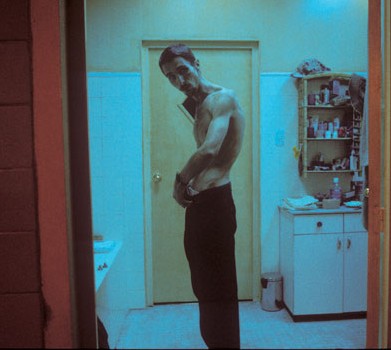
His strategy was to deflect his hunger to other activities. He would tell his body outrageous lies. 'I would feel hungry, then say to myself, 'Oh that means I really want to read.' And so I would start reading and pretending that was what I was getting my nourishment from - reading the book. It's all, obviously about games of denial."
As a hardcore music collector & completist, I read with interest a piece from February's Word magazine, 'The Infinite iPod?' posing the question, "Could one person download a copy of every song there's ever been?", based on this 'King Of The Pirates' story. This guy 'Doug' had a digital collection that already exceeded 900,000 songs and he wanted to own every piece of music there had ever been.
Edited from Word:
"Doug lived in an upper middle class neighbourhood full of stylish homes and SUVs, with a wife (former underwear model!) and 2 tech-savvy kids. He'd kitted out an extra bedroom as a 'War Room' in which 3 top-of-the-line Apple Macs sucked MP3s from the Internet via BitTorrent and then stored them on ranks of 250GB/350GB Firewire drives. His wife was bored to tears hearing about his latest collections and wanted to know why he didn't play more golf like his friends. 'Golf is the most boring game in the world,' he replied, 'What I'm doing is much more fun.'
Why was he doing this? Because he could, he said, and also - to preserve the history of music in the event of a terrorist attack. Doug implied he had sanction from 'above' and 'I just want to be a historian, a gatekeeper. I don't consider myself a pirate.'
Today there are 30,000 albums released in America each year, according to Billboard. Call it 60,000 worldwide, meaning about 700,000 songs a year. If each one uses 5MB of space in MP3 form that's 35,000GB, or 8785 iPods - a year. Extrapolate that across 100 years of recorded music, when there were fewer releases and we think there might be about 21 million existing songs. That's 1.05 million GB, 26.250 iPods or what geeks call a 'Petabyte'. Even with a superfast 8MB connection, you're looking at over 30 years of continuous downloading - assuming you can find the songs in the first place."

Russian born American stand-up whose site includes embarassing yet entertaining crooner cover versions like The Stones 'Satisfaction', Franz Ferdinand's 'Matinee' & Jacko's 'Beat It'.
GOING TO THE DOGS
Pet food maker Cesar's smart marketing competition to find people who are the spitting image of their dog (!)
'Nuff weird off-beat stuff here like setting up your own Fried Chicken joint, the in-bad taste 'chairspotting', and Lego Porn (below):
Vanity Fair's staggeringly well-written & researched pieces consistently highlight the toils & strife looming behind the glitz & glamour. The last 2 issues have been mannah from heaven, packed with corkers.
The 'Star Wars Spectacular!' naturally focused on George Lucas and all things 'Star Wars', further pieces included "The X-Rated Emperor" - Bob Guccione and the rise & fall of his 'Penthouse' empire:
"Even editorial meeting's took place at Guccione's mansion, which also housed Bob's noisy group of Rhodesian Ridgebacks. Often the dogs would trot into the meeting and run around the table barking. They were hungry.
'And we were hungry, too'' one former editor says. 'We were starved. And then Bob would throw a couple of big broiled steaks on the floor for the dogs to devour right in front of us. And we were supposed to go on with the meeting as if nothing was happening."
"Bob conjured up ever more ridiculous promotions (for Viva magazine). In Spring 1976 he asked the editor to hire an alleged rapist to write the love-advice column."
"Bob had other ideas of how he might become immortal. In the early 1980s, he decided to back the creation of the first small scale, disposable nuclear-fusion reactor as a low-cost energy source. He financed a lab in La Jolla, staffed with 82 scientists, it didn't work and Bob was out $17 million."
"Nightmare On Sunset" - A-list celebrities targeted by a wave of burglaries", "Sorcerer's Apprentice" - the friendship then fall-out over Disney CEO Michael Eisner's $140 million severance payment to ousted president Michael Ovitz and "U Want Me 2 Kill Him?" - a total hedf*ck true story of a 14 year old Manchester boy 'John' who created hundreds of fake on-line/chat-room identities to encourage 'Mark' to murder him; 'an internet soap opera moving from one scene to another, each character and story line more fantastic than the last with plots extracted from what 'John' had seen both in films and in life: thick with treachery, villainy, and betrayal."
Reading the Hollywood issue cover to cover, word for word, one Saturday in bed was bliss with these nuggets: "Eyes Wide Open" - insight into 16 year old Stanley Kubrick and his photo-journalism, "The King Who Would Be Man" - Marlon Brando's tragic struggle seen and scribed by close friend Budd Schulberg:
"When I was in Los Angeles soon after Marlon's death to look up his old friends, everyone asked, 'Have you talked to Harry Dean Stanton yet? In these last years, Harry Dean was closer to Marlon than anyone.' I found Harry Dean, a neighbor of Marlon's on Mullholland. In his late 70s, tall and gaunt and mysterious, a Kentuckian who can play a haunting harmonica and guitar, he's an unforgettable actor you've seen in a hundred movies, including The Godfather: Part II.
I told Harry Dean I had heard that he had had long conversations with Marlon at three or four in the morning, and that sometime they went on until dawn. 'So what did you talk about?'
'We talked a lot about eastern religions - Buddhism, Taoism, the Kabbalist Jews. We talked about Lao Tse in China. And Einstein came up. Einstein said that Buddhism was the only religion that could cope with modern science, and Marlon was interested in that. He was into poetry, philosophy, and religions - everything. He was curious about everything. We talked about ego from the Buddhist point of view. We talked about Shakespeare, and sometimes he would recite whole long monologues from Macbeth, Twleth Night.'
I could picture these two Hollywood seekers of solace, with the first rays of the sun beginning to peek into their lives, Harry Dean perfectly cast as a misfit and the ailing Marlon - all 300 pounds of him - beginning to look like, and trying to think like, Buddha.
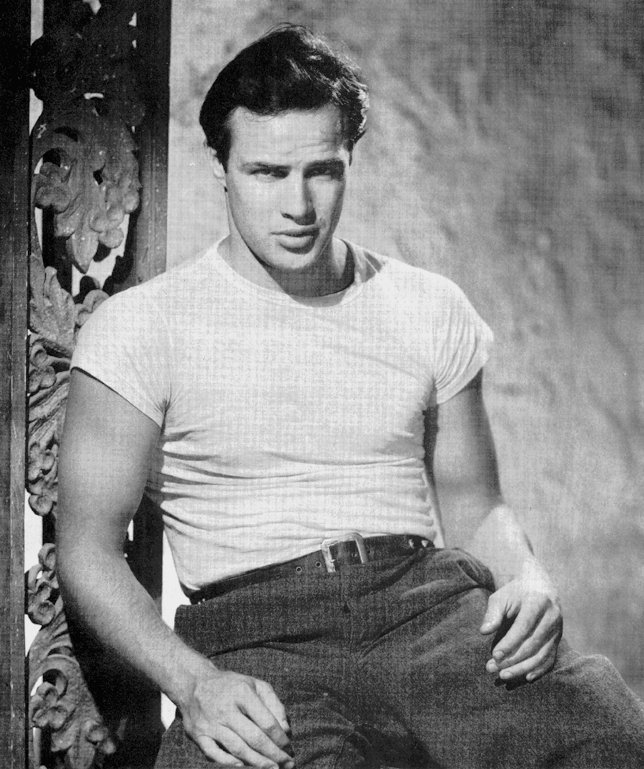
'One time Marlon suddenly asked me, 'What do you think of me?,' Stanton said. 'And I said, 'What do I think of you? I think you are nothing. NOTHING!' And Marlon began to laugh, and he went on laughing and laughing.'
I could picture Marlon. He had finally achieved his goal. Peace, peace at last. What I always wanted to be. Nothing."
The Hollywood issue also featured "Midnight Revolution" - fascinating behind the scenes of cult film, 'Midnight Cowboy', the first X-rated movie to win an Oscar, "The Garden Of Kabbalah" - a look at the mis-appropriated Jewish mysticism turned celebrity cult and "Dangerous Talents" - the turbulent making of the James Dean classic 'Rebel Without A Cause', focusing not on the obvious teen hero but equally edgy director, Nicholas Ray:
"[Post James Dean's death]....By this time Ray's troubles now went beyond unemployment and alcoholism. His gambling was pretty much out of control. He would drop $30,000 in a night and was more excited about losing than winning. Later while in Europe, Ray was reduced to acting for a 1974 soft-porno, 'Wet Dreams'."
Spot-on editorial from Raymond Stoker:

& from short interview with Bambaataa who gives Prince props:
"I knew his struggles and what he was going through [opening for] the Rolling Stones and the crowd threw stuff at him, the first time he went out on a big rock concert."
At times like a 'get up and go' 'self-help' book, Biz Stone over-zealously offers an exciting plunge into the sprawling world of the latest internet phenomenon, 'Blogging'. I learnt lots from 'Who Let The Blogs Out?', including 'Technorati' - tearing!!!
Peace - we out!
Hi, my name is, my name is, Slim Shady, Nathan Barley:
muss big up & read something that documents its subject matter in well-researched, well-written detail.
Brian-Belle Fortune's recently remixed & re-published 'All Crews' book does just that with Drum & Bass/Jungle music his subject matter. 'All Crews' is even more relevant now with the current wave of Urban/Grime e.g. Kano, The Streets, Lady Sovereign, Shystie, Dizzee Rascal, Pirate Radio, Channel U etc.

Brian, thanks for the mention; that MTV shoot seems like a lifetime ago!!!
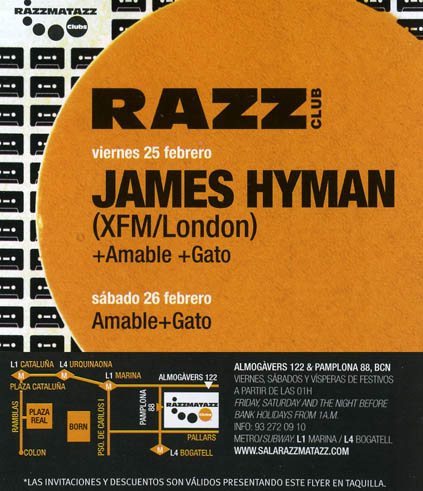
Back from another long weekend in Barcelona, DJ-ing at Razzmatazz, probably the best European club right now; not just when I play there (!!!), no seriously, the solid guest DJ line up past/present/future is unrivalled with beautiful perfect hosts Javi (pictured left) & more recently, Patricia (right) keeping everything running super-smoothly. Oh, a serious shout-out as well to the lightning-fast VJ who cued up pop-videos matching every tune I played!!!!
If I play a mixed set like Pet Shop Boys 'West End Girls (DJ Hell Mix)', Nancy Sinatra 'Bang Bang (Audio Bullys Bootleg Mix)', Prince, Alter Ego 'Rocker', White Stripes '7 Nation Army (Bootleg)', Franz Ferdinand, The Prodigy & Chemical Brothers album tracks off 'Push The Button' on radio, it's a real buzz; when I do much of the same to an open-minded welcoming packed Razzmatazz crowd & instantly see smiles, hear cheers and feel positive energy, that's an equally rewarding high.
© 2005 Green Bandana Productions Ltd. Website design by Steve Mannion.


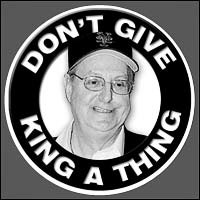
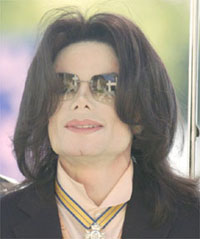
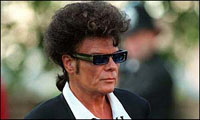
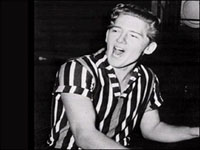

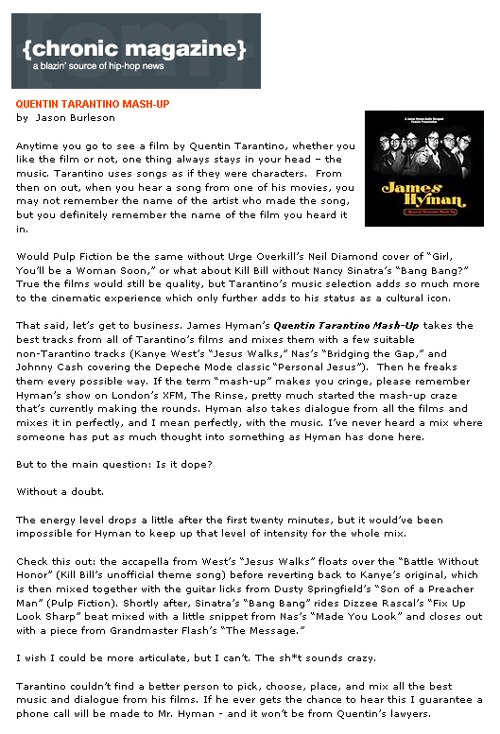


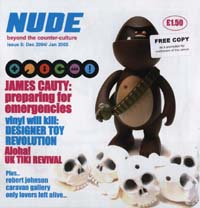
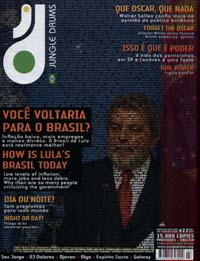
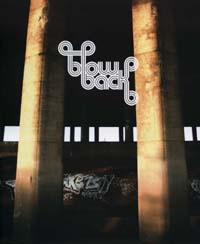
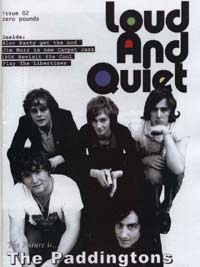
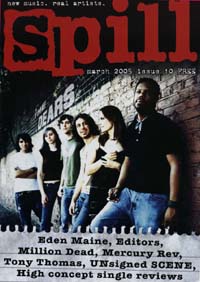
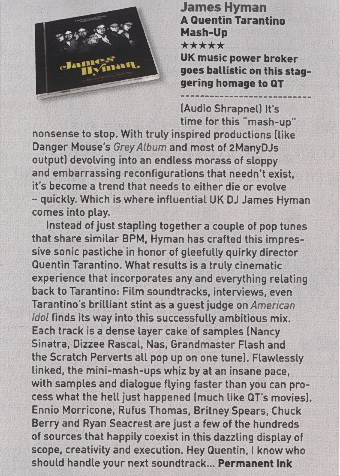
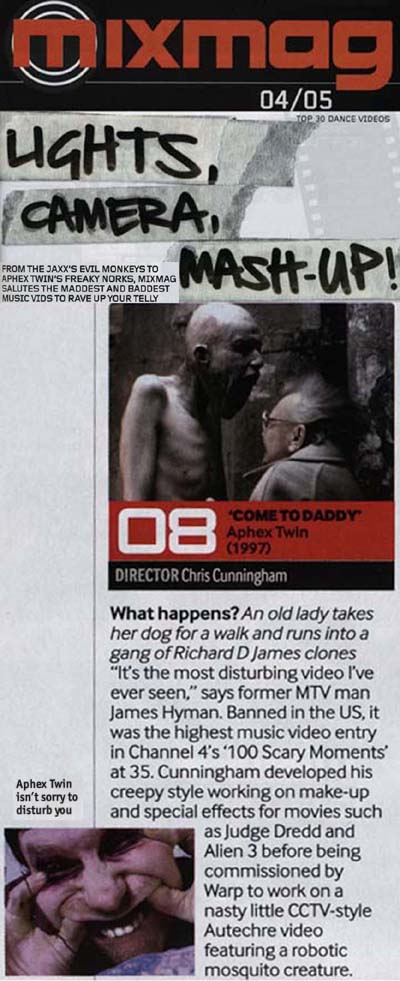


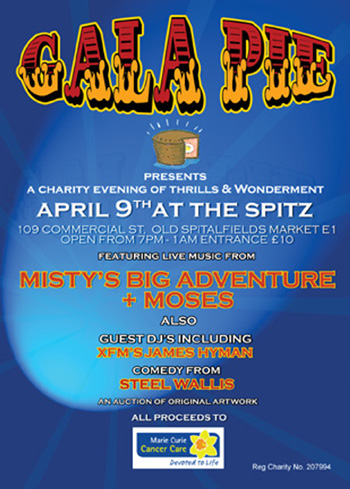
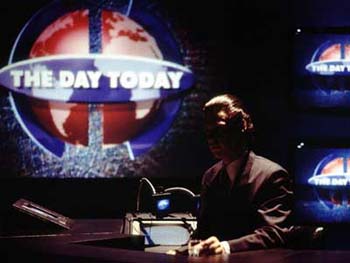
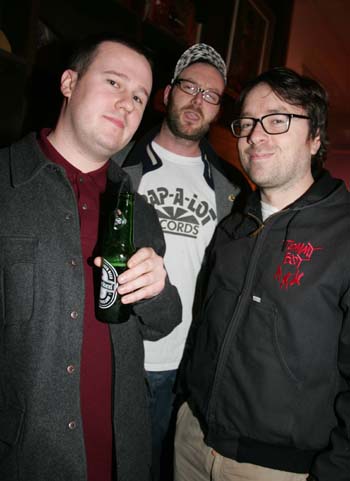
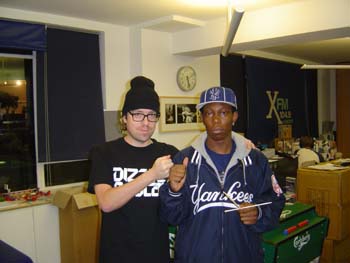
.jpg)
.jpg)

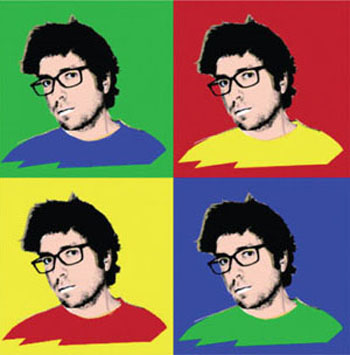
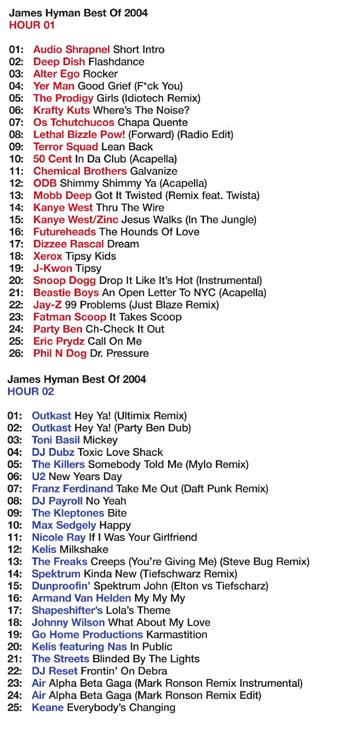
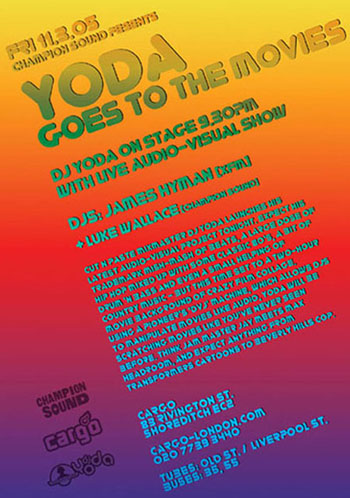
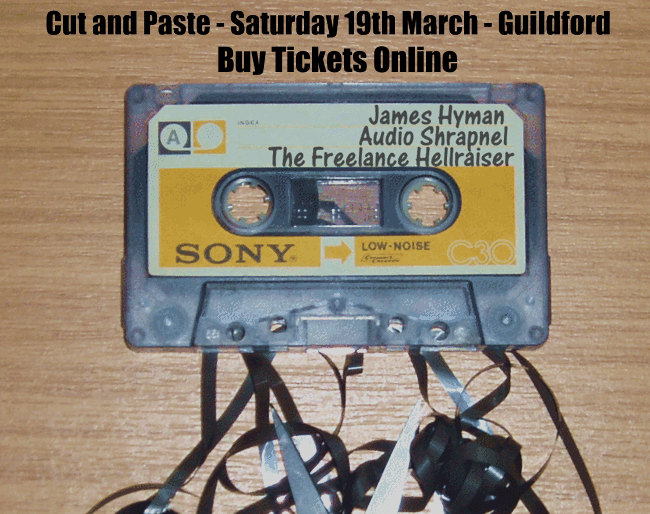
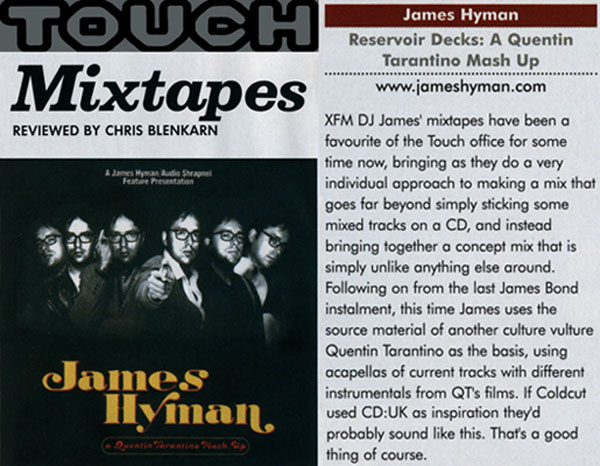
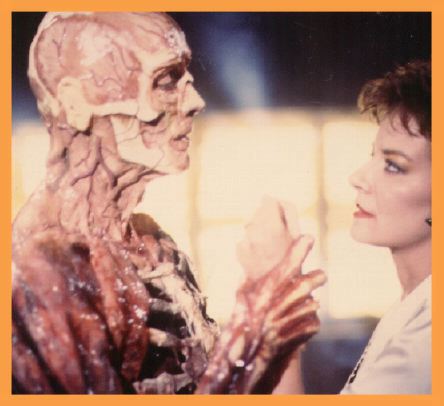
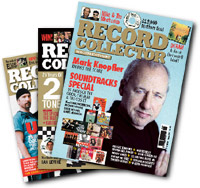
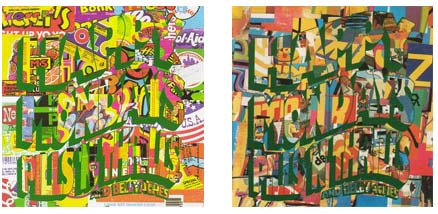
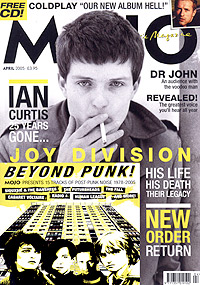
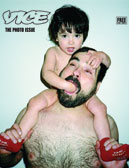
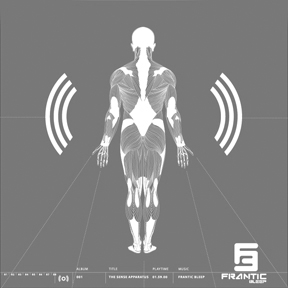
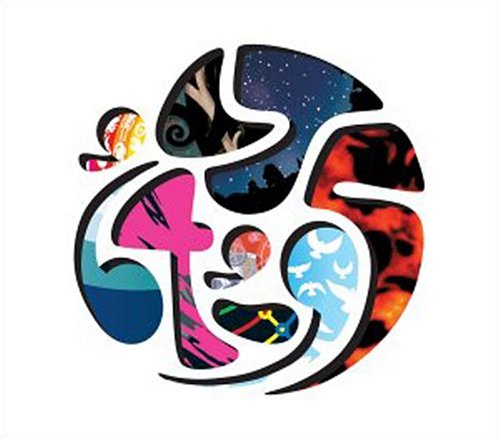
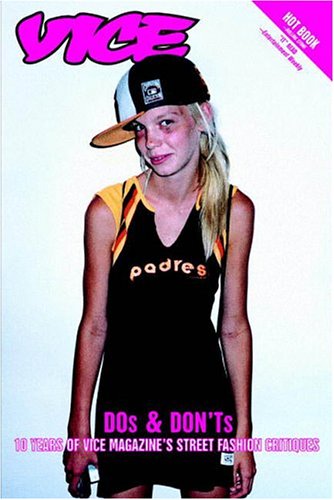
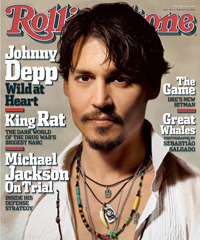
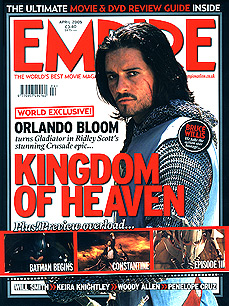


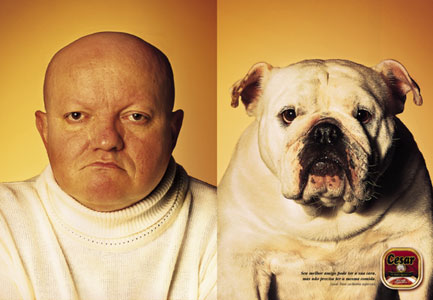
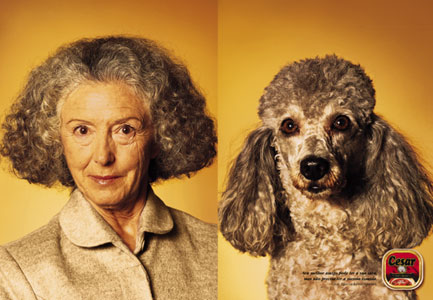
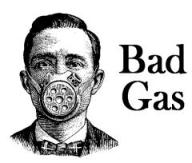
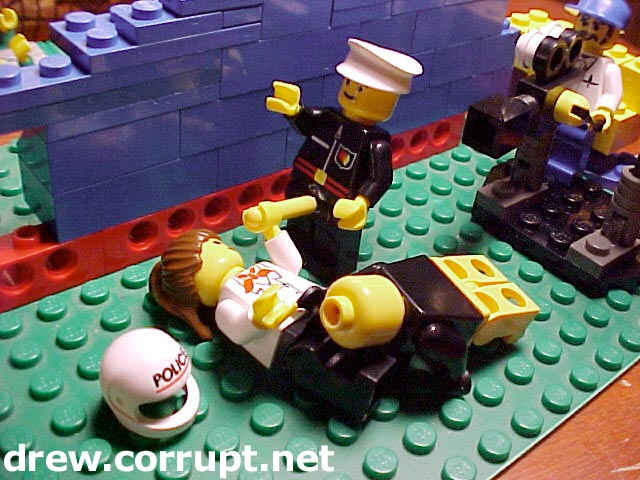
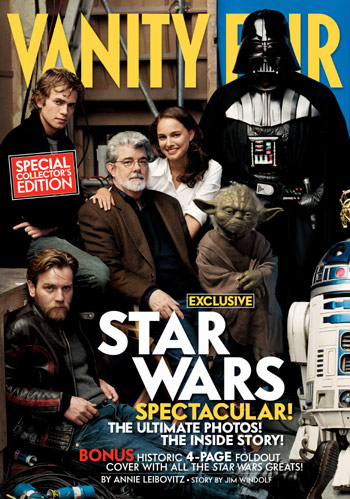
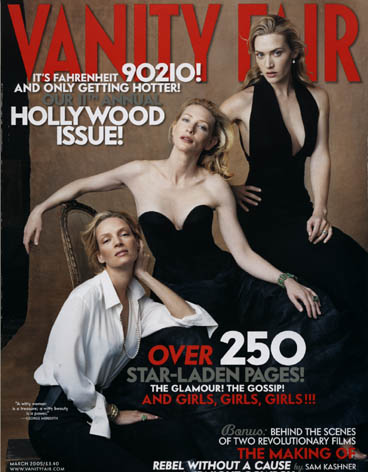
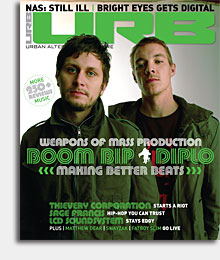
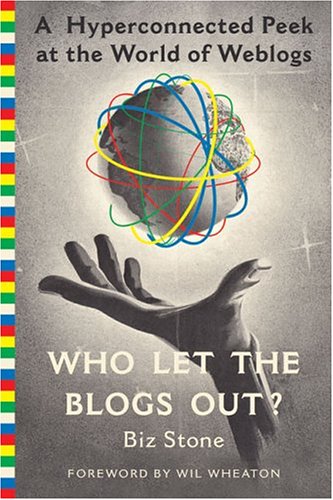

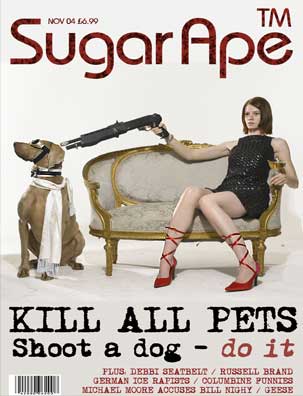
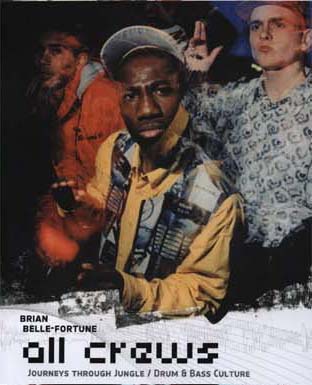
.jpg)
